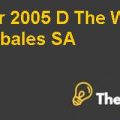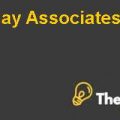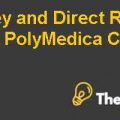
QUESTION # 01:
What is the effect of adding $ 1 billion of debt (with 10 years maturity) to the ratios as in Exhibit 8?
ANSWER # 01:
EFFECTS ON FINANCIAL RATIOS:
Debts are financing decisions adopted by the company to meet managerial and strategic objective.A certain level of debts in the capital structure of the company helps to reduce their tax liability, as interest payment on debts is tax deductible.The company has to pay a certain amount of interest payment according to the terms and condition of the debts, to the debt holder as returnsfor their investment. Probability to default in payment of debts will also increase as the debt increases the capital structure of the company.An addition of debt in the capital structure of UST Inc. reduces the tax liability of the company, as the interest payment on debts is tax deductible.
Additional $ 1 billion debts in the capital structure of the company would effect on the financial ratios of the company, as with the increase of $ 1 billion, capital structure and interest payment of the company changes. All the financial ratios decreasedramaticallyexcept the operating cash flow of sales because this ratio will not include any effect of interest payment and increased debts in the capital structure of the company. Earnings before interest and tax to interest coverage ratio andearnings before interest, tax, depreciation and amortization to interest coverage ratio would affected by the debts as they decrease to 10 times and 10.45 times respectively.This decrease in the interest coverage ratio of UST Inc. increases the probability of financial distress cost in the company. Both fund flow to sales ratio and the free cash flow sales ratio also decreases with the increase in debts of $ 1 billion in the capital structure of the company, as the cash outflow of the company increases with respect to the interest payment on the additional debts.Different financial ratios calculated are shown in the attached excel file with the sheet name ‘Ratios & Rating’.
QUESTION # 02:
What would be the implied rate of UST after having this amount (or other amounts) on the balance sheet?
ANSWER # 02:
RATING OF UST INC.:
UST Inc. implied rating on the basis of different ratios calculated from the financial statements of the company. Better rating of the company indicates the performance of the company that how effectively and efficiently management is dealing with debts and interest payment on these debts. UST Inc. ranked with different rating on the basis of different financial ratios, which are calculated above.An additional $1 billion debts in the capital structure of the company effects on the rating of the UST Inc., as the increase in debts also increases the leverage ratio of the company, which might result that company has to bearfinancial distress cost.
UST Inc. implied rating is done on the basis of different ratios of the financial statement that is earnings before interest and tax (EBIT) to sales ratio, earnings before interest, tax, amortization and depreciation (EBITDA) to sales ratio, free cash flows as well as fund flow to total debt ratio, return on capital, operating income to sale, total debt to capital and long term debts to total capital.All the ratings based on the ratios mentioned above shown in the Exhibit 1 as well as in theattached excel file with the sheet name ‘Ratios & Rating’.
QUESTION # 03:
What would be the total value of the company, including the tax shield if i) the debt is there forever, or ii) the debt disappears after 10 years
ANSWER # 03:
ADJUSTED PRESENT VALUE (APV):
Adjusted Present Value (APV) is the valuation method. Adjusted present value shows the equity value of the enterprise and present value of the benefits received from the equity financing. Adjusted present value (APV) is calculated by adjusting the present value of tax shields on the interest payment on the debts in the net present value of the company or project, as the interest payment on debts is tax deductible. Cost of capital is used to discount the free cash flows of the company instead of weighted average cost of capital (WACC), because the adjusted present value (APV) solely relates to the value of equity, that is why the cost of equity is used in adjusted present value rather than the weighted average cost of capital (WACC).
DEBTS DISAPPEAR AFTER 10 YEAR:
Firstly net present value (NPV) of the UST Inc. is calculated on the basis of the free cash flows and discounting these cash flows with the discount rate of the company that is cost of equity,and also the terminal value of cash flow is calculated.The present value of tax shields on interest payment of debts is calculated by assuming a tax rate remains constant for 10 years of the projection period,terminal value of the present value of cash flow will not be calculated, if it is assumed that debts will disappear.................
This is just a sample partial case solution. Please place the order on the website to order your own originally done case solution.












